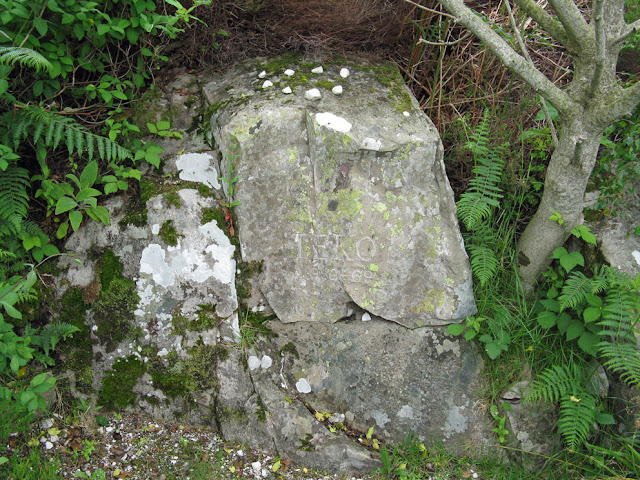One by one, over the years, I've made a point to visit sites associated with Gavin Maxwell. My interest dates back nearly 50 years to the movie Ring of Bright Water. The movie made quite an impression on me when I saw it at age 12 in the Orpheum Theatre in Seattle.
The first Maxwell site I visited was in 2008, when I set foot on the island of Soay (near Skye), where he had his shark-oil factory (see the December 17, 2016 post). The story of the shark fishery is told in his first book Harpoon at a Venture (1952).
 |
| Soay |
 |
| View from the top of Eilean Bhan lighthouse |
 |
| Teko's memorial stone |
There was still one remaining Maxwell site I wanted to see; so before heading to the Western Isles last July my wife and I spent a few days at the Eilean Iarmain Hotel on Skye. On the first full day, which was overcast with occasional rain showers, I checked the tide tables. Low water was at 4pm, and so at 2pm I left the hotel to walk a short way to the shore. Off to the east lay my destination: the lighthouse of Isle Ornsay. Along with the cottages on Eilean Bhan, five miles to the northeast, Maxwell bought the Ornsay cottages in 1961 (some sources say 1966).
The tide flats were a bit muddy, but very walkable if I kept close to the shore. The total distance to the lighthouse is a mile, and the halfway point is the island of Ornsay. The lighthouse is actually on yet another tidal island, Eilean Sionnaich, which means either fox or seagull island. I would guess the latter definition is correct, as there were no foxes around, but there were plenty of gulls wheeling high overhead.
 |
| Tide flats to Isle Ornsay (at left) |
 |
| Low tide crossing to Eilean Sionnaich |
A curious set of seahorse-balustrades topped the seawall that guards the tidal track up to the island. (Or maybe they're water-horses?)
Just above the seawall lay the forlorn walled garden. A garden of grass and weeds; it's been a long time since any crops have been cultivated here.
Between the garden and the lighthouse stood the two side by side cottages. Maxwell's intent for the cottages, as well as those on Eilean Bhan, is summarized in this excerpt from Richard Frere's excellent book Maxwell's Ghost: 'His idea was to renovate his purchases and, using their splendid wild situations and his well-known name as joint inducements, let them to the public at enormous rents.'
As described in Frere's book, the Isle Ornsay cottages were refurbished and let out to holiday makers during Maxwell's ownership. These days the cottages are private residences for the Sedgwicks. They are fortunate to have a place like this. In an area busy with tourists a more isolated place would be hard to find. (Except for the occasional nosy hiker passing by.)
There was no one in residence when I visited. Which was for the best, as I would not have gone near the cottages if anyone was there. For that matter, I'd have felt awkward even passing near them to see the lighthouse. Set next to the cottages is a beautiful memorial stone to the actress Paulita Sedgwick.
I enjoyed a snack before crossing back across the still dry shingle beach to Isle Ornsay. Before continuing I took a look at the map, and noticed there was a burial ground and chapel site on the nearby slopes of Isle Ornsay. I love finding these old chapels, and since the tide was still out I had time to look for it.
Once on Ornsay I made my way across a soggy field carpeted with tall grass. Since you can not see the ground, it can be treacherous to cross this kind of terrain. So I slowly made my way to a gate in a fence; a wire fence that seemed to encircle the whole island. Greeting me at the gate was a sign, its red letters not specifically saying 'KEEP OUT', but words to that effect: 'Please respect the privacy of the owner, and keep to the shore side of the fence.'
I would indeed respect their privacy by avoiding any houses. But I had every right to look for the old burial ground and chapel. So I climbed the fence and hiked up the grassy hillside. There was no trace of a chapel ruin that was seen here in 1928, but I knew I was in the right place because of a large, worn tombstone, on a level site that looked over to the lighthouse. (See this CANMORE page for more on the chapel that once stood here.)
It was a beautiful spot, and the owners have done a wonderful job of landscaping.
After enjoying this lovely place for a while I headed back to the shore to follow a meager path to the tidal crossing. The return to Skye was as messy as the walk out, as the route is half on gravel, half on mud flats. Even so, I meandered a little, taking time to explore two small islets before the tide isolated them. Along the way there were good views over to the hotel - the pub looked especially inviting.
After changing out of my muddy pants my wife and I enjoyed an excellent meal at the pub. After that we walked to the shore below the hotel. The tide was high, and Eilean Sionnaich was, once again, an island; its tower lit to a brilliant white by the setting sun.


















No comments:
Post a Comment